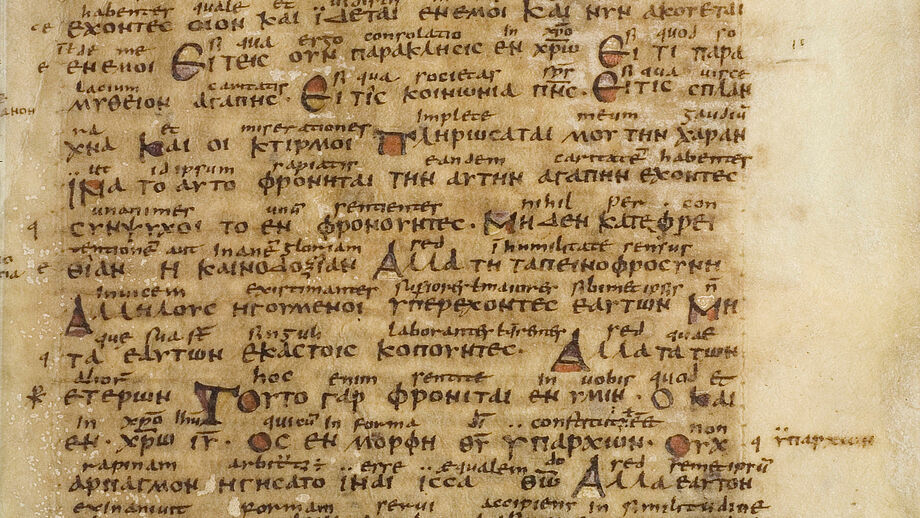Codex Boernerianus - Joint Research on the Pauline Epistles
This peculiar Greek-Latin copy of the Pauline Epistles from the 9th century has long been ignored by recent research. Yet digital indexing and analysis methods allow a comparison with two other closely related manuscripts - in this way the writing provides an extremely interesting insight into textual history up to the 3rd century. In this research the SLUB TextLab collaborates with the LMU Munich.
Codex Boernerianus (known in research as "G" or "012") is in several respects an exceptional witness to the New Testament Pauline Epistles:
- In the relatively small book - it measures only 25 x 18 centimetres - above the lines with the continuous Greek text, on a separate line above almost every word, there is one, sometimes up to three, equivalents in Latin.
- In addition, the text has numerous interesting readings. In the Letter to the Romans alone, for example, a large part of the first five verses and the last three verses are missing. This is not an oversight on the part of the copyist, for he left extra space in order to be able to add the supposedly missing text at a later date.
- In addition, there is a circumstance that is a remarkable exception in the New Testament manuscript tradition: Together with Codex Claromontanus (called "D" or "06" in research) from the 6th century and Codex Augiensis ("F" or "010"), also from the 9th century, three old, bilingual Pauline Epistle manuscripts have survived whose dependency relationships can be clearly determined. Thus it was already recognised at the end of the 19th century that F and G must have had a common template "X". And Codex D, in turn, is said to have been created on the basis of an original "Z" shared with "X".
Digital indexing of the extraordinary work
In recent years, the SLUB has conducted several workshops on digital indexing and text-critical analysis of the text of Codex Boernerianus together with staff and students of the Chair of Biblical Theology at the Institute of Protestant Theology at the TU Dresden.
Building on this, the SLUB TextLab and the Chair of New Testament and Greek-Roman Culture at the LMU Munich are currently working together on a more ambitious approach. Using the example of the Epistle to the Galatians, this should enable a text-critical comparison through its full digital indexing in the three Pauline manuscripts mentioned above. In addition, the participants hope that the combination of traditional philological and digital methods will provide better insights into the history of the text up to the 3rd century.
In the course of this work, the text of each manuscript is first typed word for word - as it appears in the manuscript. All relevant graphic features of the text (such as line breaks, conspicuously different letters or corrections) are noted in the mark-up language TEI-XML. Researchers can then collate, i.e. compare, the texts indexed in this way both traditionally and with the help of computer programmes. Unusually, the graphic characteristics and peculiar spellings of the manuscripts also play a particularly important role in this comparison. For it is precisely these that have proved to be extraordinarily important clues to the ancestry of the manuscript texts and allow conclusions to be drawn as to who copied whom.
How to use our service
Simply book an appointment via the SLUB Wissensbar if you have questions about Digital Humanities. Our staff will then sit down with you for about 30 minutes. Feel free to contact us!
textlab@slub-dresden.de
For individual concerns and enquiries, please contact our subject specialist Dr Juan Garcés.
